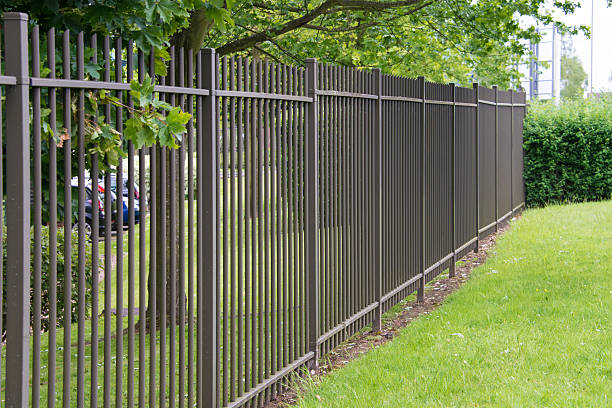Learn More About Fence Installation
Installing a fence around your property can enhance privacy, security, and curb appeal. Whether you're considering a DIY approach or hiring professionals, understanding the process, materials, and options available will help you make informed decisions. This guide covers everything from material choices to installation methods, ensuring you have the knowledge needed for a successful fencing project.

Discover the Basics of Fence Installation
Fence installation involves several key steps that ensure durability and functionality. The process typically begins with planning and measuring your property boundaries, followed by obtaining necessary permits from local authorities. Next, you’ll need to mark post locations, dig holes to appropriate depths (usually one-third of the post height), and set posts in concrete for stability. Once posts are secure, rails and panels or pickets are attached according to your chosen design. Proper spacing, leveling, and alignment are crucial throughout the process. Understanding soil conditions, property lines, and local building codes before starting will prevent costly mistakes and ensure your fence meets all requirements.
Understand Different Types of Fencing Materials
Choosing the right material significantly impacts your fence’s appearance, maintenance needs, and longevity. Wood remains a popular choice, offering natural beauty and versatility, with options like cedar, pine, and redwood providing different price points and durability levels. Vinyl fencing has gained popularity due to its low maintenance requirements and resistance to rot, insects, and weathering. Metal options include aluminum, which is lightweight and rust-resistant, and wrought iron, known for its strength and elegant appearance. Chain-link fencing provides an affordable, durable solution for security without blocking views. Composite materials combine wood fibers and plastic, offering the appearance of wood with minimal upkeep. Each material has distinct advantages regarding cost, maintenance, climate suitability, and aesthetic appeal, so consider your specific needs and local weather conditions when making your selection.
Get Tips for a Successful DIY Project
Tackling fence installation yourself can save money, but proper preparation is essential. Start by calling 811 to locate underground utilities before digging, as hitting gas or electrical lines poses serious safety risks. Invest in quality tools including a post hole digger, level, measuring tape, and power drill. Work with a helper, as handling long panels and setting posts is difficult alone. Take time to ensure posts are perfectly plumb and evenly spaced, as errors compound throughout the project. Allow concrete to cure fully before attaching rails and panels, typically 24 to 48 hours depending on weather conditions. Consider starting with a small section to develop your technique before committing to the entire perimeter. Watch instructional videos specific to your chosen material and style. Remember that professional-looking results require patience, precision, and attention to detail at every stage.
Explore Professional Installation Options
Hiring experienced contractors offers several advantages, particularly for complex projects or challenging terrain. Professional installers bring specialized equipment, expertise in local codes, and efficiency that saves time. They typically handle permit applications, ensure proper property line placement, and provide warranties on both materials and labor. When selecting a contractor, request multiple quotes to compare pricing and services. Verify licensing, insurance coverage, and references from recent projects. Ask about their experience with your chosen material and style. Professional installation costs vary based on fence type, length, terrain difficulty, and regional labor rates. While DIY projects may seem more economical initially, professionals often complete work faster and with fewer errors, potentially offsetting the higher upfront cost. They also handle unexpected challenges like rocky soil or sloped yards more effectively than most homeowners.
| Service Type | Typical Provider | Cost Estimation |
|---|---|---|
| Wood Fence Installation | Local contractors, national chains | $15-$30 per linear foot |
| Vinyl Fence Installation | Specialized fencing companies | $20-$40 per linear foot |
| Chain-Link Installation | General contractors, fencing specialists | $10-$20 per linear foot |
| Wrought Iron Installation | Metal fabrication specialists | $25-$50 per linear foot |
| DIY Material Costs | Home improvement retailers | $5-$15 per linear foot |
Prices, rates, or cost estimates mentioned in this article are based on the latest available information but may change over time. Independent research is advised before making financial decisions.
Find Answers to Common Fencing Questions
Many homeowners have similar concerns when planning fence projects. One frequent question involves permit requirements, which vary by municipality but generally apply to fences over a certain height, typically six feet. Property line disputes can be avoided by having a professional survey conducted before installation. Regarding maintenance, wood fences require periodic staining or sealing every few years, while vinyl and metal options need only occasional cleaning. Lifespan expectations differ by material: properly maintained wood lasts 15 to 20 years, vinyl can last 30 years or more, and metal fences often exceed 50 years. Weather considerations are important, as some materials perform better in specific climates. For instance, cedar resists moisture well, making it suitable for humid regions, while vinyl can become brittle in extreme cold. Understanding these factors helps you select materials and installation methods that align with your long-term goals and budget.
Installing a fence represents a significant investment in your property, whether you choose the DIY route or professional installation. By understanding the basics of installation processes, exploring various material options, and carefully weighing your choices, you can create a fence that meets your needs for privacy, security, and aesthetic appeal. Taking time to research, plan thoroughly, and either develop necessary skills or hire qualified professionals will result in a fence that enhances your property for years to come.


